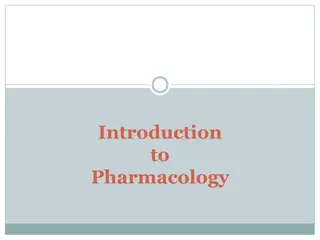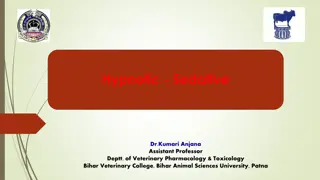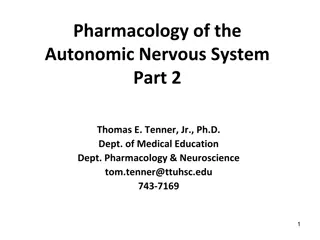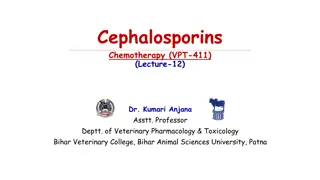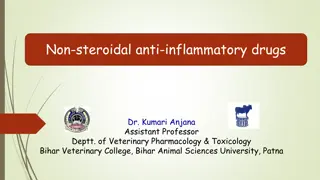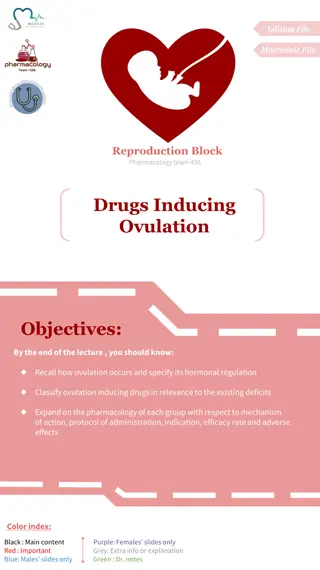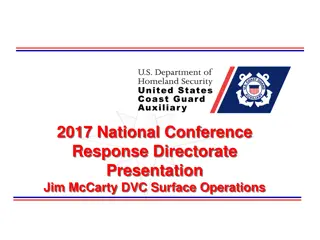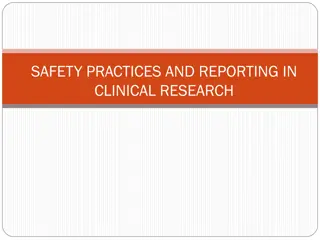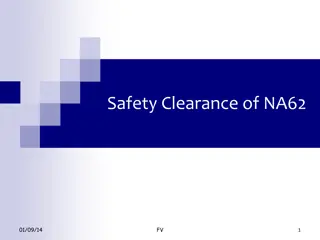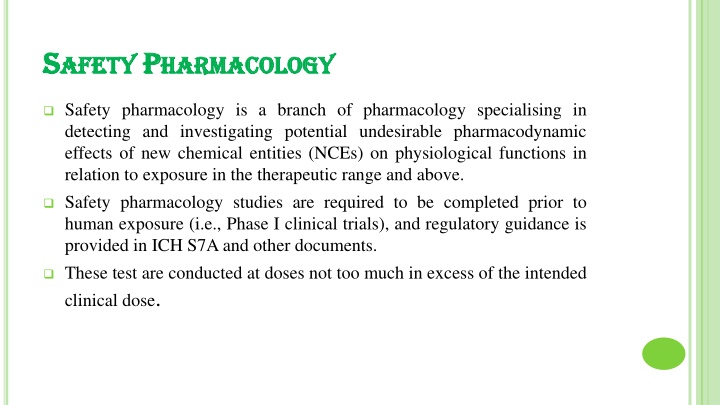
Safety Pharmacology: Origins, History, Guidelines & Importance
Safety pharmacology is a specialized branch of pharmacology focused on identifying and investigating potential adverse effects of new chemical entities on physiological functions. It plays a crucial role in drug development by assessing safety before human exposure. Learn about its origins, history, regulatory guidelines like ICH S7A/S7B, and the significance of safety pharmacology studies.
Download Presentation

Please find below an Image/Link to download the presentation.
The content on the website is provided AS IS for your information and personal use only. It may not be sold, licensed, or shared on other websites without obtaining consent from the author. If you encounter any issues during the download, it is possible that the publisher has removed the file from their server.
You are allowed to download the files provided on this website for personal or commercial use, subject to the condition that they are used lawfully. All files are the property of their respective owners.
The content on the website is provided AS IS for your information and personal use only. It may not be sold, licensed, or shared on other websites without obtaining consent from the author.
E N D
Presentation Transcript
S SAFETY AFETY P PHARMACOLOGY HARMACOLOGY Safety pharmacology is a branch of pharmacology specialising in detecting and investigating potential undesirable pharmacodynamic effects of new chemical entities (NCEs) on physiological functions in relation to exposure in the therapeutic range and above. Safety pharmacology studies are required to be completed prior to human exposure (i.e., Phase I clinical trials), and regulatory guidance is provided in ICH S7Aand other documents. These test are conducted at doses not too much in excess of the intended clinical dose.
SAFETY PHARMACOLOGY ICH S7(A+B) & E14 GUIDELINES STEP 4, MAY12, 2005 1 2 3 S7A Guideline Safety pharmacology Studies for Human Pharmaceuticals. S7B Guideline The Non-clinical Evaluation of the Potential for Delayed Ventricular Repolarization (QT Interval Prolongation) by Human Pharmaceuticals. E14 Guideline The Clinical Evaluation of QT/QTc Interval Prolongation and Proarrhythmic Potential for Non- Antiarrhythmic drugs.
ORIGIN The origins of safety pharmacology are grounded upon observations that organ functions (like organ structures) can be toxicological targets in humans exposed to novel therapeutic agents and that drug effects on organ functions (unlike organ structures) are not readily detected by standard toxicological testing.
T THE HE HISTORY HISTORY OF OF SAFETY SAFETY PHARMACOLOGY PHARMACOLOGY Safety pharmacology only came into effect in the 1990s as a result of the ICH (International Conference of Harmonization), which led to an ongoing project between scientists and regulatory bodies to set guidelines for safety and the potentially fatal effects of drugs on humans. The current guideline is known as the ICH S7A/S7B regulation. For example, in the past, pharmaceutical companies sometimes used compounds containing lead in their drug testing procedures. At the time, the lethal effects of lead on the human body were not clear and there were no regulations to set standards for this form of drug development. Today a drug must meet the regulations set by the EMA (European Medicines Agency) or the FDA (Food and Drug Administration) in the United States.
CONTENTS CONTENTS objective of safety pharmacology 1 general considerations in selection/design 2 use of in vivo and in vitro studies 3
CONTI.. sample size and use of controls 4 dose levels or concentrations of test substance 5 in vitro studies 6
AIM To characterize pharmacodynamic /pharmacokinetic (PK/PD) relationship of a drug s adverse effects using continuously evolving methodology. To protect Phase I clinical trial volunteers from acute adverse effects of drugs. To protect patients (including patients participating in Phase II and III clinical trials) To minimize risks of failure during drug development and post- marketing phases due to undesirable pharmacodynamic effects. OBJECTIVE OF SAFETY PHARMACOLOGY SP studies are described in the international conference on harmonization (ICH) S7a and S7b guidelines. According to ICH S7A
To identify undesirable pharmacodynamic properties of a substances. To investigate the mechanism of action of a adverse pharmacodynamic effect . To help protect clinical trial participants and patients receiving marketed products from potential adverse effects of pharmaceuticals To evaluate adverse pharmacodynamic and pathophysiological effect of a substance .
GENERAL CONSIDERATIONS IN SELECTION/DESIGN 1) Effects related to the therapeutic class of the test substance, since the mechanism of action may suggest specific adverse effects. 2) Adverse effects associated with members of the chemical or therapeutic class 3) ligand binding or enzyme assay data suggesting a potential for adverse effects 4) Results from previous safety pharmacology studies, from secondary pharmacodynamic studies, from toxicology studies, or from human.
I IMPORTANCE MPORTANCE OF OF S SAFETY AFETY P PHARMACOLOGY HARMACOLOGY Determination of dosage regime, subject selection of novel compounds. Helps in risk evaluation and hazard identification. Critical step in design of clinical trials.
S SAFETY AFETY P PHARMACOLOGY HARMACOLOGY S STUDIES TUDIES The core battery SP studies, performed according to GLP standards as per ICH guidelines, involves the investigation of major vital organisms. TIER- 1 TIER- 2 SUPPLEMENTARY STUDIES CORE BATTERY CVS CNS Respiratory Renal GI system Others
CONTINUE.. 1. Safety Pharmacology Core Battery 2. Supplemental Safety Pharmacology Studies To adverse effects functions not addressed by the core battery or repeated dose toxicity studies evaluate pharmacodynamic on organ potential Safety pharmacology core battery is to investigate the effects of the test substance on vital functions. Follow-up Studies For Safety Pharmacology Core Battery These are meant to provide a greater depth of understanding than, or additional knowledge to, that provided by the core battery on vital functions for potential adverse pharmacodynamic system a)
CENTRAL NERVOUS SYSTEM TIER- 1 In Follow-up studies In Core battery Motor activity Behavioral changes Coordination Sensory/motor reflex response Body Temperature Learning and memory Ligand-specific binding Neurochemistry Visual & auditory examination
EVALUATION METHODS 1. Functional Observation Battery (FOB) 2. Irwin s test FOB method of evaluation involves Neurological and Neuropathological investigations This method is to evaluate the qualitative effect substance on behavioural and physiological functions and also duration of action of test
Other evaluation techniques Emerging Techniques Rotarod Hot plate test, Tail flick, paw pressure Photoelectric interruption techniques. Passive avoidance tests Pentylenetetrazol seizure tests . Electroencephalography (EEG) 1) Automated video systems . Integrated video and EEG systems. 1. 2) 2. beam 3) 4) (PTZ) 5) 6)
2. CARDIOVASCULAR SYSTEMS(CVS) Core Battery Follow up Studies Cardiac output Ventricular contractility Vascular resistance Endogenous & exogenous substances on the Cardiovascular response Blood Pressure Heart rate
Evaluation methods Electrocardiogram(ECG) Established techniques In vitro hERG assay The effects of an NCE on the hERG channel can be detected using screening methodologies such as Manual patch clamp Automated high-throughput patch clamp Isolated organ preparation Whole heart preparation Isolated purkinje fibre
3.RESPIRATORYSYSTEM Core battery Respiratory rate Airway resistance Tidal volume compliance Haemoglobin oxygen saturation pulmonary arterial pressure. Follow up studies blood gases blood pH Airway resistant compliance Pulmonary artery pressure.
EVALUATIONMETHODS Plethysmography Head out Plethysmography whole body plethysmography Respiratory parameters: o Inspiratory Time (Ti, ms) o Expiratory Time (Te, ms) o Peak Inspiratory Flow (PIF, ml/s) o Peak Expiratory Flow (PEF, ml/s) o Tidal Volume (TV, ml) o Respiratory Rate (ResR, breaths/min) o Relaxation Time (Tr, ms)
HERG ASSAY human ether a-go-go related gene was first identified in late 1980 s in a mutant fruit fly. hERG encodes the inward rectifying voltage gated potassium channel in the heart (IKr) which is involved in cardiac repolarization. Inhibition of the hERG current causes QT interval prolongation resulting in potentially fatal ventricular tachyarrhythmia. In humans it is expressed widely, including in the brain, adrenal gland, thymus, retina and in cardiac and smooth muscle tissues.
STRUCTURE OF HERG A detailed atomic structure for hERG based on X-ray crystallography is not yet available, but structures have recently been solved by electron microscopy. In the laboratory the heterologously expressed hERG potassium channel comprises 4 identical alpha subunits, which form the channel's pore through the plasma membrane. Each hERG subunit consists of 6 transmembrane alpha helices, numbered S1-S6, a pore helix situated between S5 and S6, and cytoplasmically located N- and C-termini.
CONTI. The S4 helix contains a positively charged arginine or lysine amino acid residue at every 3rd position and is thought to act as a voltage- sensitive sensor, which allows the channel to respond to voltage changes by changing conformations between conducting and non- conducting states (called 'gating'). Between the S5 and S6 helices, there is an extracellular loop (known as 'the turret') and 'the pore loop', which begins and ends extracellularly but loops into the plasma membrane. The pore loop for each of the hERG subunits in one channel face into the ion- conducting pore and are adjacent to the corresponding loops of the 3 other subunits, and together they form the selectivity filter region of the channel pore.
SUPPLEMENTAL SAFETY PHARMACOLOGY STUDIES TIER-2 Renal/Urinary System Renal parameters should be assessed are - Urinary volume, specific gravity, Osmolality, pH, fluid/electrolyte balance, proteins, cytology, and blood chemistry determinations such as blood urea nitrogen, Na+, Cl-, K+, creatinine and plasma proteins
KIDNEY INJURY MARKER FUNCTIONAL MARKER LEAKAGE MARKER Glucose aspartate aminotransferase (AST), Alanine amino- transferase (ALT), lactate dehydrogenase (LDH), -glutamyl transferase (GGT), alkaline phosphatase (ALP) N-acetyl- -D-glucosaminidase NAG) New kidney injury molecule-1 (KIM-1) and Markers Clusterin (CLU) Urinary Protein Albumin Calcium ( - These kidney injuries are assessed primarily using histology
2. GASTROINTESTINAL SYSTEM Gastric secretion Gastrointestinal injury potential Bile secretion Transit time in vivo Ileal contraction in vitro Gastric pH measurement Gastric emptying Intestinal motility Emesis induction
EVALUATIONMETHODS Barium sulphate (BaSO4) or a charcoal test meal Pylorus ligation test Emerging techniques Endoscopy Biomarkers EMG Citrulline miR-194 Calprotectin
A ALTERNATE LTERNATEMODELS MODELS Zebrafish model: anticonvulsant activity, locomotor activity, behavioural paradigms such as addiction, memory and anxiety. human embryonic stem cell derived cardiomyocytes (hESC-CM) and human inducible pluripotent stemcell derived cardiomyocytes (hiPS-CM) as models of in vitro high throughput drug screening and CVS safety assessment
CONDITIONSUNDERWHICH STUDIESARENOT NECESSARY Safety pharmacology studies may not be needed for locally applied agents. e.g., dermal or ocular . cytotoxic agents with novel mechanisms of action, there may be value in conducting safety pharmacology studies. For biotechnology-derived products that achieve highly specific receptor targeting, it is often sufficient to evaluate safety pharmacology endpoints as a part of toxicology and/or pharmacodynamic studies, and therefore safety pharmacology studies can be reduced or eliminated for these products. For biotechnology-derived products that represent a novel therapeutic class and/or those products that do not achieve highly specific receptor targeting, a more extensive evaluation by safety pharmacology studies should be considered A new salt having similar pharmacokinetics and pharmacodynamics properties- safety pharmacology studies are not necessary



